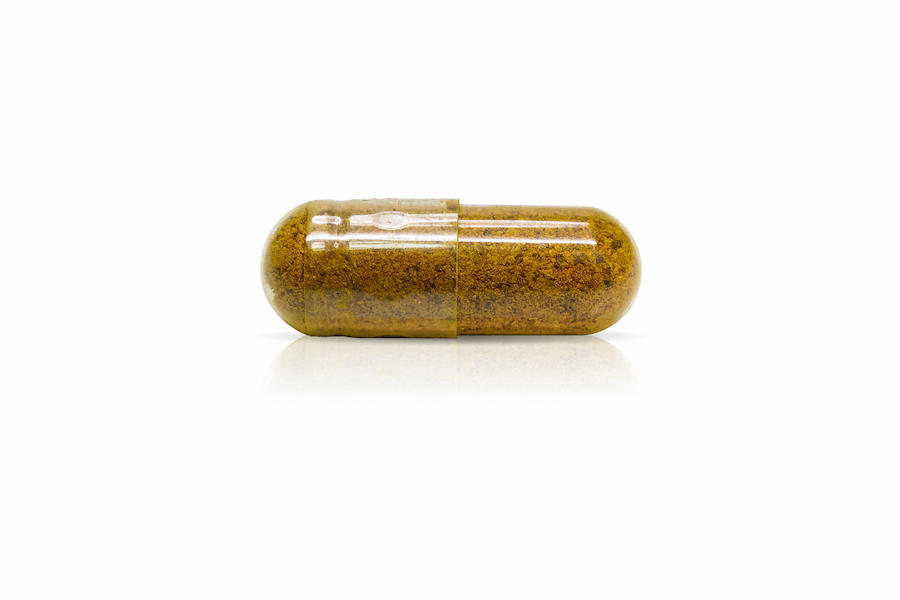Capsules are a convenient form of kratom, but how do they compare to other forms (like liquids)? If you’re trying capsules for the first time, it’s important to be aware of both the risks and benefits of taking kratom in capsule form. While most kratom consumers find that capsules are easy to incorporate into their routine, understanding possible effects can help you decide if capsules are right for you.
Keep reading for a complete guide to kratom capsules, including tips for first-timers.
What Are Kratom Capsules?
Kratom capsules contain raw leaf powder or a highly concentrated extract made from the leaves of the kratom tree. These leaves are typically dried and then turned into liquid or powder, then placed into capsules. The finished product resembles a pill that looks similar to many common medications or supplements.
Capsules vs. Tablets
Although often confused with one another, capsules and tablets are different. Both are taken orally (by mouth) and are made with similar ingredients, but differ in the way they are made.
The main area of contrast between capsules and tablets is their composition, since tablets are usually made using only kratom and some sort of binding agent, such as:
- Cellulose
- Gelatin
- Starch
- Sucrose
Capsules, on the other hand, are generally made using kratom extract powder encased in some sort of gel capsule. The gel capsule is often made from some sort of gelatin or cellulose, and is why some capsules are called “gel caps”.
Confused? The good news is, you can often tell a capsule from a tablet based on appearance. Many tablets appear or feel chalky or powdery. When looking at a capsule, you can often see where the two sides of the capsule are joined together. Sometimes, the capsule is clear enough for you to see the contents inside, while other times the capsule encasing is colored to appear more appealing.

Uses for Kratom Capsules
Although there isn’t a government-supported medical use for kratom, it’s been used for hundreds of years in Southeastern Asia as an herbal remedy to fight fatigue and improve productivity. Capsules are one of the most popular forms of kratom, thanks to their flavorless taste and ability to be taken on-the-go.
Since many forms of liquid or powdered kratom need added sweeteners to overpower the naturally bitter botanical taste, capsules may also be the top choice for health-conscious consumers. Without an abundance of added sugars, kratom capsules can deliver more of what you want (and less of what you don’t, like refined sugars).
In addition to being portable, capsules are also pre-measured. This means you’ll get the exact same amount each time you take a capsule, as opposed to having to personally measure out the substance each time (like you might have to do with liquids).

Potential Effects
It’s important to keep in mind that, since everyone’s body is different, kratom affects everyone differently. While most users describe modest amounts of kratom as invigorating or energizing, there are downsides to taking an excessive serving size or using kratom against direction.
For reasons that aren’t entirely clear, kratom may impact body and behavior in many ways (for better or worse), including:
- Changes in appetite and weight
- Elevated energy and focus
- Dry mouth
- Changes in mood
- Skin changes (i.e. itching or sweating)
Generally, positive effects are reported at low serving sizes and with short-term use. In fact, one study reports that consumers found kratom helpful in meeting daily obligations.
Adverse Effects are More Common at High Serving Sizes
A crucial aspect of kratom to note is that effects seem to be dependent on the serving size, according to existing science. In other words, the more kratom you ingest, the more likely you are to experience unwanted effects.
Like any substance, ingesting too much kratom can have negative effects. The following effects should be noted and may need to be taken seriously, such as seeking medical attention:
- Digestive or gastrointestinal discomfort (constipation, nausea, vomiting)
- Drowsiness
- Heart palpitations
- High blood pressure
- Mood swings
- Sleep problems (i.e. insomnia)
Unfortunately, not much is known about long-term kratom use. So far, available research suggests that skin changes, organ damage, excessive weight loss, and troubling mood disorders may be linked with using too much kratom for too long. Fortunately, there’s a way to use kratom where the potential for these effects are reduced.

Quick Tips for Capsule First-Timers
One of the best ways to ensure a pleasurable experience is to look for a high-quality, reputable kratom brand. Since regulation isn’t necessarily standard across the board when it comes to kratom, seeking out a company that has gone above and beyond in terms of compliance and safety is key.
Finding the Right Product and Manufacturer
Since kratom is widely available, it’s sometimes hard to tell what exactly is in your product. Companies who cut corners have been found to have contaminants in their capsules, such as heavy metals or bacteria.
It’s important to seek out companies who take extra steps to ensure your safety as a consumer. Looking for the following certifications or accreditations can help:
- AKA GMP: This stands for American Kratom Association Good Manufacturing Practices qualified kratom vendor.
- Third Party Testing: Terms like “Certificate of Analysis” on the product or product page may help you find out whether a product has been tested to detect harmful chemicals and confirm its kratom content.
- Tested for Purity: Many reputable companies conduct their own series of tests to ensure purity. For example, the purity of MIT45’s extraction process is ensured by the Triple Purification Process.
Double Check If Interactions Exist
The risk for negative interactions increases when you mix kratom with other substances. In particular, mixing kratom with alcohol, tobacco, or recreational drugs may cause dangerous (and potentially life-threatening) effects.
Mixing kratom with certain medications and supplements can also be ill-advised. For example, some chemicals in kratom affect the way your liver metabolizes drugs and medicines. If you rely on a certain medication to improve your quality of life, the results of mixing kratom and medications can be quite serious.
As with starting any new substance, you’ll want to carefully inspect your labels and check with your healthcare providers before introducing kratom into your wellness routine. If you’re taking supplements or regularly ingesting substances like caffeine, it’s important to talk with a holistic healthcare provider about those, too.
Look on the Label for Additives
Not all additives are “evil.” For example, added herbs may have a synergistic effect with other substances and ultimately have a beneficial effect on the body. Our Black Label capsules contain slippery elm bark, ginger root, and black pepper, which are thought to provide potential health properties.
On the other hand, some additives can detract from the overall value of the capsule. In particular, ingredients added as a byproduct of the manufacturing process can make the capsule lower-quality, and may even be a danger to human health. Be careful when shopping for kratom capsules, and decide for yourself if additives like caffeine will enhance or detract from the experience for you.
Explore Different Veins
Since there are different varieties, strains, or veins of kratom, there are different types of capsules to choose from, too. Different veins are believed to have slightly different effects. Trying out different types until you achieve the desired effects can help you find what capsules are right for you.
Don’t know where to start when it comes to different strains? Explore the following types of capsules:
- Green Vein Capsules
- Red Vein Capsules
- White Vein Capsules
Lean into Learning
Education is also key! Learning all you can as a consumer can help protect you from potentially dangerous interactions, like failing to recognize a capsule is filled with powerful extract rather than raw powder. One great way to stay informed is to subscribe to our email communications. You can scroll down to the bottom of this page to sign up!
How Much Kratom is in a Capsule?
The amount of kratom in each capsule generally depends on the brand. For example, each of our Black Label Caps contain 150 mg of 45% Mitragyna speciosa extract (kratom leaf extract) per 1 unit (1 capsule). Raw leaf red, green, and white vein capsules each contain 1 gram per 2 units.
Suggested Serving Size
Opting for capsules may be a safety measure in and of itself! With liquids or powders, it may be easier to take too many “scoops” accidentally. With capsules, kratom is already in pre-measured amounts, which may be a more intuitive method of ingestion. Whether you’re consuming powders, liquids, or capsules, checking the label for recommended serving sizes is recommended.
Although research hasn’t confirmed exact amounts, a serving size of 1-5 grams is considered low. For capsule first-timers, it’s recommended to start with the smallest serving size possible and work your way up. If you can’t find a small enough serving size, making your own capsules from kratom powder may be an option you want to explore.
It can also be helpful to alert a close friend or family member when you are taking kratom for the first time. In rare cases, as with trying any new substance for the first time, an allergic reaction may occur. While this is rare, for your peace of mind, having someone you trust “on call” can contribute to you having a pleasant and safe first-time kratom experience. Typically, it’s also best to try kratom for the first time during the day (when you’ll be awake), as opposed to at night (when waning consciousness could increase the risk of a serious situation).
In Conclusion on Kratom Capsules
Capsules are a convenient, pre-measured way to take your kratom on-the-go! For health-conscious consumers, capsules are a great way to incorporate kratom into a wellness routine. Becoming well-versed in serving sizes and other kratom information can help ensure a safe and pleasurable experience with capsules.
References
Drug Enforcement Administration. KRATOM (Mitragyna speciosa korth). Deadiversion.usdoj.gov. Published March 2023.
Grinspoon P. Kratom: Fear-worthy foliage or beneficial botanical? Health.harvard.edu. Published September 2019.
National Center for Complementary and Integrative Health. Kratom. Nccih.nih.gov. Published June 2023.
National Institute on Drug Abuse. Kratom. Nida.nih.gov. Published March 2022.
American Addiction Centers Editorial Staff. Kratom Short-Term, Long-Term, Effects, and Addiction Treatment. Drugabuse.com. Published February 2023.
Operation Supplement Safety. Kratom. Opss.org. Published March 2022.
Singh V, Mulla N, Wilson JK, Umansky A, Lee J, Stead T, Ganti L. Intractable nausea and vomiting in naïve ingestion of kratom for analgesia. Int J Emerg Med. 2020;13(42).




